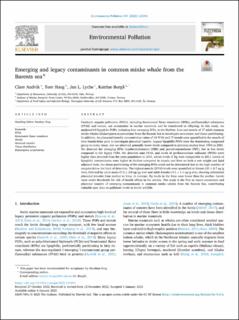| dc.description.abstract | Persistent organic pollutants (POPs), including brominated flame retardants (BFRs), perfluoroalkyl substances (PFAS) and metals, can accumulate in marine mammals and be transferred to offspring. In this study, we analyzed 64 lipophilic POPs, including four emerging BFRs, in the blubber, liver and muscle of 17 adult common minke whales (Balaenoptera acutorostrata) from the Barents Sea to investigate occurrence and tissue partitioning. In addition, the placental transfer concentration ratios of 14 PFAS and 17 metals were quantified in the muscle of nine female-fetus pairs to investigate placental transfer. Legacy lipophilic POPs were the dominating compound group in every tissue, and we observed generally lower levels compared to previous studies from 1992 to 2001. We detected the emerging BFRs hexabromobenzene (HBB) and pentabromotoluene (PBT), but in low levels compared to the legacy POPs. We detected nine PFAS, and levels of perfluorooctane sulfonate (PFOS) were higher than detected from the same population in 2011, whilst levels of Hg were comparable to 2011. Levels of lipophilic contaminants were higher in blubber compared to muscle and liver on both a wet weight and lipid adjusted basis, but tissue partitioning of the emerging BFRs could not be determined due to the high number of samples below the limit of detection. The highest muscle ΣPFAS levels were quantified in fetuses (23 ± 8.7 ng/g ww), followed by adult males (7.2 ± 2.0 ng/gg ww) and adult females (4.5 ± 1.1 ng/g ww), showing substantial placental transfer from mother to fetus. In contrast, Hg levels in the fetus were lower than the mother. Levels were under thresholds for risk of health effects in the whales. This study is the first to report occurrence and placental transfer of emerging contaminants in common minke whales from the Barents Sea, contributing valuable new data on pollutant levels in Arctic wildlife. | en_US |
